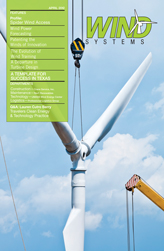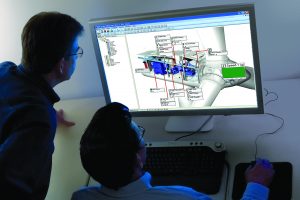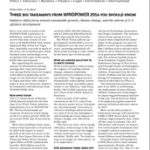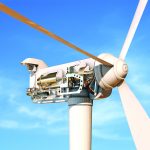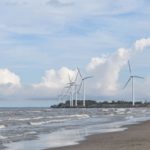As offshore wind energy projects move farther offshore into deeper waters, wind turbines on floating platforms instead of the traditional fixed bottom platforms become more economical. Floating platforms have been used with success in the offshore oil industry, but there are a number of engineering challenges associated with offshore floating wind turbines (OFWTs). One important challenge is the increased loading on the blades and tower due to the higher inertial and gravitational forces caused by the motion of the floating platform.
To help mitigate the extra loading caused by platform motion, Gordon Stewart—a doctoral student at UMASS Amherst—and I investigated the use of structural control techniques for OFWTs. Structural control is traditionally a field of civil engineering that has been successfully employed for over 20 years in large buildings and bridges in order to reduce loading caused by wind and earthquakes, as well as to increase building inhabitant comfort by reducing acceleration of the structure. Many devices have been developed for this purpose, the most common being a tuned mass damper (TMD). This device, in its simplest passive form, consists of a mass on a horizontal track attached to the building via a spring and damper. The spring stiffness is tuned so that the mass vibrates at a structure natural frequency, and the damper is used to dissipate vibrational energy from the structure. The mass of the TMD is typically between 1-4 percent of the total structure mass.
In order to apply these systems in floating wind turbines, it is necessary to construct a simulation tool with which to model both the wind turbine as well as the structural control device. FAST (Fatigue, Aerodynamics, Structures, and Turbulence) is a powerful tool developed by NREL for simulating wind turbines that has the capability of modeling OFWTs. I developed a modification for FAST in order to provide the capability of simulating passive tuned mass dampers, located in the nacelle or the platform, and oriented to oscillate in the direction of the wind or perpendicular to this direction. With this modeling tool, named FAST-SC, the effects of TMDs on the various floating platform designs can be quantified in terms of fatigue and ultimate load reductions.
Using this modeling tool, an optimization analysis was conducted to find the best TMD spring and damping parameters for several values of the TMD mass, in terms of fatigue damage reduction of the NREL 5MW reference turbine mounted on three floating platforms, as well as a monopole. The floating platforms used were the ITI Energy Barge, stabilized by its large buoyant water plane area, the MIT/NREL Tension-Leg Platform, a mooring line stabilized design, and the OC3 Hywind Spar Buoy, which derives its stability from a counter-balance. The ideal way to optimize the TMDs for these platforms would be to wrap an optimization routine around FAST-SC itself, which would set the spring and damping constants, run a FAST-SC simulation, then modify the parameters based on the results of the simulation, and repeat. However, FAST-SC is computationally expensive, and this optimization routine could need hundreds or even thousands of iterations to arrive at an optimum. Since only the structural dynamic functionality of FAST-SC is needed for optimization (no aerodynamics are needed), a simplified structural model was developed for each of the platforms. This model was used in the optimization algorithm instead of FAST-SC.
Due to the high degree of nonlinearity of the models, a standard optimization routine may fail to find the true optimum for the system. Instead, a genetic algorithm was employed to solve this problem. A genetic algorithm uses a scheme similar to natural selection in order to determine the best design for a system. This reduced computation time and found the true optimum TMD configuration for each floating platform. These optimum constants for the spring and damper were then simulated in a number of FAST-SC under realistic wind and wave conditions in order to determine the magnitude of the fatigue and ultimate load reductions. The results show promise for passive TMDs, with load reductions of over 20 percent in some cases. Ongoing work at the University of Massachusetts Amherst is investigating realistic designs of TMDs that can be implemented in a floating wind turbine, such as tuned liquid column dampers.
Offshore floating wind turbines show promise for use in deep waters, but the increased loading from platform dynamics may lead to high structure costs. Utilizing optimized passive TMDs will reduce this loading, which will allow designers to use less material and can lead to reduced overall system cost.
















